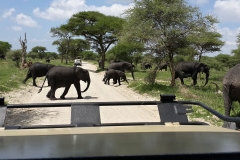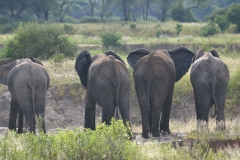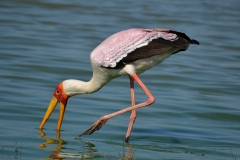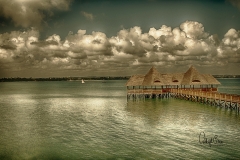











Mount Kilimanjaro is situated entirely within the borders of Tanzania, although it is situated close to the border of Kenya. It is situated 3 degrees, or about 340 km, south of the Equator.
Kilimanjaro comprises three distinct volcanic cones:
Kibo 19,340 feet (5,895 meters)
Mawenzi 16,896 feet (5,149 meters)
Shira 13,000 feet (3,962 meters)
Kilimanjaro with its gleaming glaciers, is a magnificent mountain. It stands majestically amidst vast open plains, inviting you to the challenge to climb to the top through the farms, rain forest, pass through the moorland, to highland desert and witness the eternal snow on “The Roof of Africa.”
Kilimanjaro is one of the worlds highest free standing mountains, its bulk looming 4800m above an undulating plain that averages 1000m above sea level.
On a clear day, it can be seen from more then 150 kms away. Its peak is permanently snow covered, though only 3 degrees below the equator. Kilimanjaro can be climbed by any physically fit person. No climbing experience is necessary.
Weather: Kilimanjaro can be climbed at any time of the year, but there are two rainy seasons – Late March to Mid June and October to November. The best Months are January to March and July to October, usually cloudless days. During the day temperature at 4000m tends to be 15°C. When the sun is covered, temperatures drop. At night, temperature falls to -10°C. At the summit, temperatures are about 5°C during the day and drop to between -18°C and -22°C at night.
Climbing Kilimanjaro: Around 25,000 people per year attempt to summit the top of Africa.
Uhuru peak is the highest summit of Mount Kilimanjaro. The highest peak on Mawenzi is Hans Meyer Point, which can only be reached by mountaineers.
Kilimanjaro contains an example of virtually every ecosystem on earth – glacier, snowfields, deserts, alpine moorland, savannah, and tropical jungle, all of which found on the mountain.
The city of Moshi is just over 30 km from the summit, and is the most common pre and post-trip base for climbers.
Porters and guides accompany each group. The Kilimanjaro Central Control Unit has a reliable, equipped rescue team on the Marangu route. Equipment such as sleeping bags, mountain boots, thick sweaters, balaclava, gloves and so on are required, but we can arrange to have this equipment rented and ready for you to use. Kilimanjaro is not just a mountain to conquer, but also changing scenes and landscapes to enjoy, and rich in a wide variety of birdlife, flora and fauna.
Kilimanjaro Climb is an experience of a lifetime, highly recommended to the adventurous traveller willing to forego some of life’s luxuries for a few days. The Marangu Route walking expedition can be undertaken without past mountaineering experience.
There are five routes by which you can summit the peak
VIA Marangu Route
The Marangu or main route is by far the most popular way up Kilimanjaro. The forest is very beautiful and Maundi Crater is worth a visit just for the flowers and scenery. There are wonderful views of Kibo and Mawenzi.
This is one of the most popular routes, nicknamed the ‘Coca-cola’ route followed by ninety percent of all climbers. The path is well defined and climber friendly. It offers accommodation at Mandara, Horombo, and Kibo en route and accommodation on this route consists of built mountain huts providing adequate shelter, bottled water, beer and soft drinks. This is a very scenic route with good views of Mawenzi and excellent prospects for viewing wildlife.
Distances: Marangu Gate to Mandara Hut 3-4 hrs 9000 ft 2,725m
(The forest trail is slower)
Mandara Hut to Horombo Hut 5-7 hrs 12335 ft /3,780m
Horombo Hut to Kibo Hut 5-6 hrs 15520ft/ 4,730m
Kibo Hut to Gillman’s Point 5-6 hrs 18635ft. /5680m.
Gillman’s Point to Uhuru Peak: 1-2 hrs 19,340ft/5896m
Day 1: Transfer from Arusha or KIA (Kilimanjaro International Airport) for Marangu, at the foot of Mt. Kilimanjaro. Dinner and overnight at the Kibo Hotel, Marangu Hotel or Mountain Inn.
Day 2: After breakfast, start the climb through fascinating rain forests till you reach the first Hut-MANDARA. Meals and overnight at the hut.
Day 3: After breakfast, follow the ascending path through the alpine meadow. The altitude begins to change and slows down your pace while enjoying the flora and the view of Mawenzi and Kibo peaks. Arrive at the Horombo hut 12km from Mandara. Meals and overnight at the hut.
Day 4: After breakfast, resume the climb; the landscape becomes rugged and rocky and groundsels and lobelias appear. Climb to Kibo hut. Meals and overnight at the hut.
Day 5: The beginning of the last ascent is made at about 1:00 a.m. in the morning while the scree is still frozen. Climb the very steep part of the route to GILMAN’S POINT (most difficult and tiring part)UHURU PEAK is reached within an hours walk along the crater’s rim.
Start the descent to Horombo hut for overnight.
Day 6: Continue the descent to Marangu Gate. Return to your hotel. After lunch, rest for the day. Dinner and overnight at the hotel.
VIA MACHAME ROUTE:
This is probably the most beautiful route up Kilimanjaro. With a lovely gradual ascent through forest you emerge to see wide views of the moorland on Shira Plateau, Kibo and the Western Breach. Beautiful vegetation enhances the scenery along this route.
Distances
Machame village to Park gate: 2 hrs
Park gate to trailhead: 2 hrs
Trailhead to Machame Huts: 4-5 hrs :10,000ft/3000m
Machame Huts to Shira Hut 5 hrs : 12,500ft/3800m
Shira Hut To Barranco Hut : 13,000ft/3900m
Barranco to Barafu Hut : 15,500ft/4600m
Barafu Hut to Stela point – Uhuru Peak : 19,340ft/5896m
MACHAME ROUTE
Machame is a beautiful route up Kilimanjaro. With a lovely gradual ascent through forest you emerge to see wide views of the moorland on Shira Plateau, Kibo and Western Breach. Machame is a little less popular than the Marangu route, a bit more popular for those who like climbing.
Day 1: You arrive at your hotel. Dinner and overnight stay
Day 2: Transfer from your hotel to the Kilimanjaro National Park Gate at Machame. From here you trek through the lush forest to Machame Hut. Stay/Camp overnight
Day 3: Leaving the forest, the path follows a steep ridge, passing through heather and open moorlands, and crossing a large gorge to reach Shira Hut. Stay/Camp overnight.
Day 4: You turn eastwards and continue ascending through the dry landscape before dropping again to reach Barranco Hut. Stay/Camp overnight.
Day 5: The path climbs steeply out of the Barranco Valley, crosses the Karanga Valley,then turns north to reach Barafu Hut. Stay overnight.
Day 6: A long day and an early start to rach the crater rim at Stella Point in time for sunrise. Then to Uhuru Peak () – the highest point in Africa.
Afterwards descend to Mweka Hut. Stay overnight
Day 7: Descend to the park gate, from where you are transferred back to your hotel. Dinner and overnight.

Mount Meru at 4,566m is regarded as a dormant volcano, since lava flowed from it as recently as 100 years ago.
Though low-key by comparison to nearby Kilimanjaro, Mount Meru is regarded by many perhaps the most rewarding mountain to climb in East Africa.
Meru is just as interesting as Kilimanjaro from the biological point of view and, because comparatively few people climb it, you are more likely to see forest animals.
Mount Meru is the product of the same volcanic activity that formed the Great Rift Valley 15 to 20 million years ago, and it attained a height similar to that of Kilimanjaro until a massive eruption tore out its eastern wall 250,000 years ago.
The Arusha and Meru people deify Mount Meru as a rain god.
It is unlikely that any local person actually climbed to the 4566m peak prior to Fritz Jaeger´s pioneering ascent in 1904.
Mount Meru is the second highest mountain in Tanzania, at 4566metre (14,979feet).
It is overshadowed by Kilimanjaro, its famous neighbor, and frequently overlooked by visitors. But Meru is a spectacular mountain; a trek involves beautiful hiking through the grassland and forest on the mountain’s lower slopes, followed by a dramatic and exhilarating ridge-walk to the summit.
The following is a five day itinerary, however the actual number of days on the mountain is three.
Day 1: Pick up from Kilimanjaro International Airport, transfer to the base hotel for dinner and overnight stay.
Day 2: Transfer from your hotel to the National Park Gate at Momella. From here you pass through lush forest, crossing the Ngare Nanyuki River to reach
Miriakamba Hut (8337ft./2541m).Camp overnight.
Day 3: The path continues to ascend steeply through pleasant forest glades and giant heather to reach Saddle Hute (11,713ft./3570m). From here it’s possible to reach the summit of Little Meru (12450ft./3794m) and return to Saddle Hut. Camp overnight.
Day 4: An early start to reach Rhino Point, then on to the summit at 14,981ft./ 4566m. From here descend all the way down to Momella Gate to meet your vehicle and transfer back to the base hotel. Dinner and overnight at the hotel.

Towering steeply over the kilombero Plains about 350km southwest of Dar es Salaam are the wild, lushly forested slopes of the Udzungwa Mountains, portions of which are protected as part of udzungwa Mountains National Park.
There are no roads in Udzungwa; instead there are about eight major and several lesser hiking trails winding through various sections of the park.
The Udzungwa’s high degree of endemism and biodiversity is due, in large part, to the area’s constant climate over millions of years, which has given species a chance to evolve.
Another factor is the Udzungwa altitudinal range. From the low lying killombero valley south of the park (at approximately 200m) to Luhombero peak (the peak’s highest point at 2579m), there is continuos forest, making this one of the few places in Africa with continuos rainforest over such a great span.
Udzungwa is also a home of about six types of primates, including four endemic species both occur nowhere else in the world – the Iringa red Colobus monkey, the Sanje crested mangabey, Matundu galago and Mountain dwarf galago – the plateau supports even if they are not often seen by visitors, animals like; leopard, elephant, buffalo and hyena. So, depending on where and when you go, you may need escort by an armed ranger. Wild dogs as well as rare species of forest birds, four of which were only discovered last few years are commonly spotted. Real biodiversity hotspot!! The park offers the greatest altitudinal range of the Eastern Arc Mountains and has an incredible range of biological species as well as several endemic species. The undisturbed forest areas offer good hiking opportunities and bird watching and the park receives very few tourists.
Main activity in Udzungwa is walking. Available trails and itinerary for Udzungwa provided by Safari Solutions :
Short Day Trails:
Prince Bernhard: 1 km / 40 minutes – Small waterfall, baboons, primates, red duiker, birds, good Bokela Mountain view
Sonjo : 2.5km / 3 hrs – 2 waterfalls, primates 4 species endemics: Sanje crested Mangabey, Iringa red Colobus, Matundu galago and Mountain dwarf galago, birds, miombo vegetation
Sanje : 5 km / 4 hrs – 3 waterfalls in stages that drop from 200m, 70m and 40m respectively, primates, birds, butterflies, a variety of vegetation
Long Overnight Trails:
Mwanihama: 38 km/ 3 days (Going & Return) The summit is at 2500m and trail passes through different vegetation types according to altitude. Mwanihana is more challenging trail that leads to the high plateau, with its panoramic views over surrounding sugar plantations, before ascending to Mwanihana peak, the second-highest point in the range.
Lumemo : 65Km/ 5 days ( Going & Return ) The trail passes along the saddle between Luhomero and Mwanihama peaks. May encounter herds of buffalo, elephant and good bird watching.
When to visit: Possible all year round although slippery in the rains. The dry season is June-October before the short rains but be prepared for rain anytime.

An exclusive excursion over the Serengeti plains, offering unparalleled panoramic views of the awe-inspiring landscape. A very popular excursion for those of our clients willing to spend that little bit extra, and can be added on to any safari that includes a night in the Serengeti, at any of the lodges. Only two balloons fly each day, each with a capacity of only 12 people.
Itinerary: Commencing with a pre-dawn pick up from your lodge, and a drive of 45 minutes to the launch site, you then enter your hot-air balloon at dawn for a breathtaking one hour flight. As you float over the plains in the increasing light, the pilot will take you up to at least 1,000 foot altitude for a breathtaking panoramic view of the plains. Much of the remainder of the flight will be at a tree-top or even grass-top level for some close up views of the wildlife, flora and fauna below.
On landing, you are met by the ground support team with a bottle of champagne. Then its off to the breakfast table, which will have been set up under a fine umbrella tree close to the landing spot. You are served a full cooked English breakfast with some tropical additions – a fine spread served on bone china with silver cutlery and crystal glasses. The balloon safari is complete at around 9.30 a.m., and you are returned to the Seronera lodge to be met by our driver-guide. As this is an early morning excursion, you can add this on even if you are in a group where not all members would like to participate.
In case of cancellation by the operating company due to climatic conditions or any other reason, you will have the option of a flight the following morning if this fits into your itinerary, or a full refund.
Contact us for current pricing.